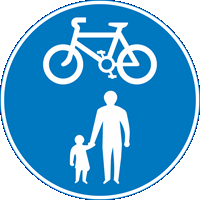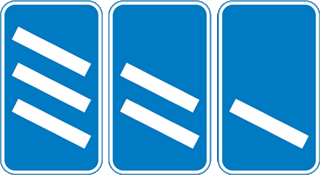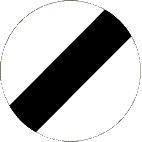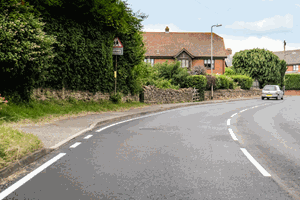You have 57 minutes to answer 50 multiple choice theory test questions. You need to answer at least 43 out of 50 questions correctly to pass. You can review your answer after each question or you can review all of your answers at the end of the test. Best of luck!
Test Quick View
Click on an answer to view the correct choice along with the explanation.
Correct Answer: D
Explanation: You should plan your overtaking to take into account any hazards ahead. In this picture the marking indicates that you are approaching a junction. You will not have time to overtake and move back into the left safely.
Explanation: You should plan your overtaking to take into account any hazards ahead. In this picture the marking indicates that you are approaching a junction. You will not have time to overtake and move back into the left safely.
Correct Answer: B
Explanation: If people are waiting to use a pedestrian crossing, slow down and be prepared to stop. Don't wave them across the road since another driver may not have seen them, not have seen your signal and may not be able to stop safely.
Explanation: If people are waiting to use a pedestrian crossing, slow down and be prepared to stop. Don't wave them across the road since another driver may not have seen them, not have seen your signal and may not be able to stop safely.
Correct Answer: B
Explanation: A green flashing beacon on a vehicle means the driver or passenger is a doctor on an emergency call. Give way to them if it's safe to do so. Be aware that the vehicle may be travelling quickly or may stop in a hurry.
Explanation: A green flashing beacon on a vehicle means the driver or passenger is a doctor on an emergency call. Give way to them if it's safe to do so. Be aware that the vehicle may be travelling quickly or may stop in a hurry.
Correct Answer: B
Explanation: This sign shows a shared route for pedestrians and cyclists: when it ends, the cyclists will be rejoining the main road.
Explanation: This sign shows a shared route for pedestrians and cyclists: when it ends, the cyclists will be rejoining the main road.
Correct Answer: A
Explanation: Older people may have impaired hearing, vision, concentration and judgement. They may also walk slowly and so could take a long time to cross the road.
Explanation: Older people may have impaired hearing, vision, concentration and judgement. They may also walk slowly and so could take a long time to cross the road.
Correct Answer: B
Explanation: The exit from a motorway is indicated by countdown markers. These are positioned 90 metres (100 yards) apart, the first being 270 metres (300 yards) from the start of the slip road. Move into the left-hand lane well before you reach the start of the slip road.
Explanation: The exit from a motorway is indicated by countdown markers. These are positioned 90 metres (100 yards) apart, the first being 270 metres (300 yards) from the start of the slip road. Move into the left-hand lane well before you reach the start of the slip road.
Correct Answer: B
Explanation: You would generally see this sign at the approach to a pedestrian-only zone.
Explanation: You would generally see this sign at the approach to a pedestrian-only zone.
Correct Answer: D
Explanation: Don't force your way through. Show courtesy and consideration to other road users. Although you have priority, make sure oncoming traffic is going to give way before you continue.
Explanation: Don't force your way through. Show courtesy and consideration to other road users. Although you have priority, make sure oncoming traffic is going to give way before you continue.
Correct Answer: A
Explanation: Knowing the colours of the reflective studs on the road will help you judge your position, especially at night, in foggy conditions or when visibility is poor.
Explanation: Knowing the colours of the reflective studs on the road will help you judge your position, especially at night, in foggy conditions or when visibility is poor.
10. You are approaching traffic lights that have been on green for some time. You should
Mark one answer
B
C
D
Correct Answer: B
Explanation: The longer traffic lights have been on green, the greater the chance of them changing. Always allow for this on approach and be prepared to stop.
Explanation: The longer traffic lights have been on green, the greater the chance of them changing. Always allow for this on approach and be prepared to stop.
11. You are on a motorway. You see this sign on a lorry that has stopped in the right-hand lane. You should
Mark one answer

B
C
D
Correct Answer: C
Explanation: Sometimes work is carried out on the motorway without closing the lanes. When this happens, signs are mounted on the back of lorries to warn other road users of roadworks ahead.
Explanation: Sometimes work is carried out on the motorway without closing the lanes. When this happens, signs are mounted on the back of lorries to warn other road users of roadworks ahead.
Correct Answer: A
Explanation: You should only flash your headlights to warn others of your presence. Don't use them to greet others, show impatience or give priority to other road users. They could misunderstand your signal.
Explanation: You should only flash your headlights to warn others of your presence. Don't use them to greet others, show impatience or give priority to other road users. They could misunderstand your signal.
13. You are following a long lorry. The driver signals to turn left into a narrow road. What should you do?
Mark one answer
B
C
D
Correct Answer: B
Explanation: When turning into narrow roads articulated and long vehicles will need more room. Initially they will need to swing out in the opposite direction to which they intend to turn. They could mask another vehicle turning out of the same junction. DON'T be tempted to overtake them or pass on the inside.
Explanation: When turning into narrow roads articulated and long vehicles will need more room. Initially they will need to swing out in the opposite direction to which they intend to turn. They could mask another vehicle turning out of the same junction. DON'T be tempted to overtake them or pass on the inside.
14. At a crossroads there are no signs or road markings. Two vehicles approach. Which has priority?
Mark one answer
B
C
D
Correct Answer: A
Explanation: At a crossroads where there are no 'give way' signs or road markings be very careful. No vehicle has priority, even if the sizes of the roads are different.
Explanation: At a crossroads where there are no 'give way' signs or road markings be very careful. No vehicle has priority, even if the sizes of the roads are different.
Correct Answer: C
Explanation: Puffin crossings have infra-red sensors which detect when pedestrians are crossing and hold the red traffic signal until the crossing is clear. The use of a sensor means there is no flashing amber phase as there is with a pelican crossing.
Explanation: Puffin crossings have infra-red sensors which detect when pedestrians are crossing and hold the red traffic signal until the crossing is clear. The use of a sensor means there is no flashing amber phase as there is with a pelican crossing.
Correct Answer: C
Explanation: This distance is the equivalent of 18 car lengths. Try pacing out 73 metres and then look back. It's probably further than you think.
Explanation: This distance is the equivalent of 18 car lengths. Try pacing out 73 metres and then look back. It's probably further than you think.
17. You think the driver of the vehicle in front has forgotten to cancel their right indicator. You should
Mark one answer
B
C
D
Correct Answer: D
Explanation: The driver may be unsure of the location of a junction and turn suddenly. Be cautious and don't attempt to overtake.
Explanation: The driver may be unsure of the location of a junction and turn suddenly. Be cautious and don't attempt to overtake.
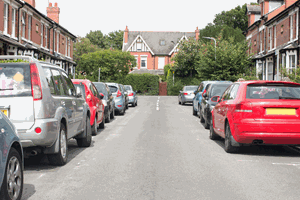
B
C
D
E
F
Correct Answer: A, B
Explanation: On roads where there are many parked vehicles you should take extra care. You might not be able to see children between parked cars and they may run out into the road without looking. People may open car doors without realising the hazard this can create. You will also need to look well down the road for oncoming traffic.
Explanation: On roads where there are many parked vehicles you should take extra care. You might not be able to see children between parked cars and they may run out into the road without looking. People may open car doors without realising the hazard this can create. You will also need to look well down the road for oncoming traffic.
Correct Answer: B
Explanation: Only overtake on the left if traffic is moving slowly in queues and the traffic on your right is moving more slowly than the traffic in your lane.
Explanation: Only overtake on the left if traffic is moving slowly in queues and the traffic on your right is moving more slowly than the traffic in your lane.
Correct Answer: D
Explanation: Be aware that other traffic might still be clearing the junction. Make sure the way is clear before continuing.
Explanation: Be aware that other traffic might still be clearing the junction. Make sure the way is clear before continuing.
Correct Answer: A
Explanation: Where you see this road marking you should give way to traffic on the main road. It might not be used at junctions where there is relatively little traffic. However, if there is a double broken line across the junction the 'give way' rules still apply.
Explanation: Where you see this road marking you should give way to traffic on the main road. It might not be used at junctions where there is relatively little traffic. However, if there is a double broken line across the junction the 'give way' rules still apply.
Correct Answer: A
Explanation: Most motoring organisation websites allow you to create a detailed plan of your trip, showing directions and distances. Some also include advice on rest and fuel stops. The Traffic England website will give you information on roadworks and accidents, along with expected delay times.
Explanation: Most motoring organisation websites allow you to create a detailed plan of your trip, showing directions and distances. Some also include advice on rest and fuel stops. The Traffic England website will give you information on roadworks and accidents, along with expected delay times.
Correct Answer: D
Explanation: Various route planners are available on the internet. Most of them give you various options allowing you to choose the most direct, quickest or scenic route. They can also include rest and fuel stops and distances. Print them off and take them with you.
Explanation: Various route planners are available on the internet. Most of them give you various options allowing you to choose the most direct, quickest or scenic route. They can also include rest and fuel stops and distances. Print them off and take them with you.
24. You are on a three-lane motorway. A red cross is shown above the hard shoulder and mandatory speed limits above all other lanes. This means
Mark one answer
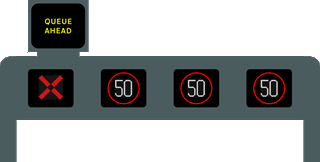
B
C
D
Correct Answer: D
Explanation: A red cross above the hard shoulder shows it is closed as a running lane and should only be used for emergencies or breakdowns. At busy times within an Active Traffic Management (ATM) area the hard shoulder may be used as a running lane. This will be shown by a mandatory speed limit on the gantry above.
Explanation: A red cross above the hard shoulder shows it is closed as a running lane and should only be used for emergencies or breakdowns. At busy times within an Active Traffic Management (ATM) area the hard shoulder may be used as a running lane. This will be shown by a mandatory speed limit on the gantry above.
25. Some junctions controlled by traffic lights have a marked area between two stop lines. What is this for?
Mark one answer
B
C
D
Correct Answer: B
Explanation: These are known as advanced stop lines. When the lights are red (or about to become red) you should stop at the first white line. However if you have crossed that line as the lights change you must stop at the second line even if it means you are in the area reserved for cyclists.
Explanation: These are known as advanced stop lines. When the lights are red (or about to become red) you should stop at the first white line. However if you have crossed that line as the lights change you must stop at the second line even if it means you are in the area reserved for cyclists.
26. An injured person has been placed in the recovery position. They are unconscious but breathing normally. What else should be done?
Mark one answer
B
C
D
Correct Answer: A
Explanation: After a casualty has been placed in the recovery position, their airway should be checked to make sure it's clear. Don't leave them alone until medical help arrives. Where possible do NOT move a casualty unless there's further danger.
Explanation: After a casualty has been placed in the recovery position, their airway should be checked to make sure it's clear. Don't leave them alone until medical help arrives. Where possible do NOT move a casualty unless there's further danger.
B
C
D
Correct Answer: C
Explanation: Be aware this is just the braking distance. You need to add the thinking distance to this to give the OVERALL STOPPING DISTANCE. At 50 mph the typical thinking distance will be 15 metres (50 feet), plus a braking distance of 38 metres (125 feet), giving an overall stopping distance of 53 metres (175 feet). The distance could be greater than this depending on your attention and response to any hazards. These figures are a general guide.
Explanation: Be aware this is just the braking distance. You need to add the thinking distance to this to give the OVERALL STOPPING DISTANCE. At 50 mph the typical thinking distance will be 15 metres (50 feet), plus a braking distance of 38 metres (125 feet), giving an overall stopping distance of 53 metres (175 feet). The distance could be greater than this depending on your attention and response to any hazards. These figures are a general guide.
28. You arrive at a serious motorcycle crash. The motorcyclist is unconscious and bleeding. Your THREE main priorities should be to
Mark three answers
B
C
D
E
F
Correct Answer: A, B, F
Explanation: Further collisions and fire are the main dangers immediately after a crash. If possible get others to assist you and make the area safe. Help those involved and remember DR ABC, Danger, Response, Airway, Breathing, Compressions. This will help when dealing with any injuries.
Explanation: Further collisions and fire are the main dangers immediately after a crash. If possible get others to assist you and make the area safe. Help those involved and remember DR ABC, Danger, Response, Airway, Breathing, Compressions. This will help when dealing with any injuries.
29. At an incident a small child is not breathing. To restore normal breathing you should breathe into their mouth
Mark one answer
B
C
D
Correct Answer: A
Explanation: If a young child has stopped breathing, first check that the airway is clear. Then give compressions to the chest using one hand (two fingers for an infant) and begin mouth to mouth resuscitation. Breathe very gently and continue the procedure until they can breathe without help.
Explanation: If a young child has stopped breathing, first check that the airway is clear. Then give compressions to the chest using one hand (two fingers for an infant) and begin mouth to mouth resuscitation. Breathe very gently and continue the procedure until they can breathe without help.
B
C
D
Correct Answer: A
Explanation: Use the full beam headlights only when you can be sure that you won't dazzle other road users.
Explanation: Use the full beam headlights only when you can be sure that you won't dazzle other road users.
Correct Answer: B
Explanation: If you're travelling on an icy road extra caution will be required to avoid loss of control. Keeping your speed down and using the highest gear possible will reduce the risk of the tyres losing their grip on this slippery surface.
Explanation: If you're travelling on an icy road extra caution will be required to avoid loss of control. Keeping your speed down and using the highest gear possible will reduce the risk of the tyres losing their grip on this slippery surface.
Correct Answer: B
Explanation: The continuous white line shows the edge of the carriageway. It can be especially useful when visibility is restricted, for example at night or in bad weather. It is discontinued where it crosses junctions, lay-bys etc.
Explanation: The continuous white line shows the edge of the carriageway. It can be especially useful when visibility is restricted, for example at night or in bad weather. It is discontinued where it crosses junctions, lay-bys etc.
33. What advice should you give to a driver who has had a few alcoholic drinks at a party?
Mark one answer
B
C
D
Correct Answer: B
Explanation: Drinking black coffee or waiting a few hours won't make any difference. Alcohol takes time to leave the body. A driver who has been drinking should go home by public transport or taxi. They might even be unfit to drive the following morning.
Explanation: Drinking black coffee or waiting a few hours won't make any difference. Alcohol takes time to leave the body. A driver who has been drinking should go home by public transport or taxi. They might even be unfit to drive the following morning.
B
C
D
Correct Answer: D
Explanation: Ensure that your vehicle can be seen by other traffic. If possible, park your car off the road in a car park or driveway to avoid the extra risk to other road users.
Explanation: Ensure that your vehicle can be seen by other traffic. If possible, park your car off the road in a car park or driveway to avoid the extra risk to other road users.
35. You are driving over a level crossing. The warning lights come on and a bell rings. What should you do?
Mark one answer
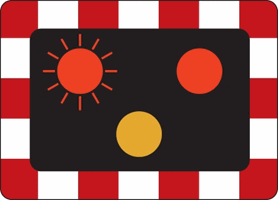
B
C
D
Correct Answer: B
Explanation: Keep going, don't stop on the crossing. If the amber warning lights come on as you're approaching the crossing, you MUST stop unless it is unsafe to do so. Red flashing lights together with an audible signal mean you MUST stop.
Explanation: Keep going, don't stop on the crossing. If the amber warning lights come on as you're approaching the crossing, you MUST stop unless it is unsafe to do so. Red flashing lights together with an audible signal mean you MUST stop.

B
C
D
Correct Answer: C
Explanation: Advance warning triangles fold flat and don't take up much room. Use it to warn other road users if your vehicle has broken down or there's been an incident. Place it at least 45 metres (147 feet) behind your vehicle or incident on the same side of the road or verge. Place it further back if the scene is hidden by, for example, a bend, hill or dip in the road. Don't use them on motorways.
Explanation: Advance warning triangles fold flat and don't take up much room. Use it to warn other road users if your vehicle has broken down or there's been an incident. Place it at least 45 metres (147 feet) behind your vehicle or incident on the same side of the road or verge. Place it further back if the scene is hidden by, for example, a bend, hill or dip in the road. Don't use them on motorways.
Correct Answer: B, E, F
Explanation: Walking or cycling are good ways to get exercise. Using public transport also gives the opportunity for exercise if you walk to the railway station or bus stop. Leave the car at home whenever you can.
Explanation: Walking or cycling are good ways to get exercise. Using public transport also gives the opportunity for exercise if you walk to the railway station or bus stop. Leave the car at home whenever you can.
38. Which THREE things can you, as a road user, do to help the environment?
Mark three answers
B
C
D
E
F
Correct Answer: B, D, F
Explanation: Although the car is a convenient form of transport it can also cause damage to health and the environment, especially when used on short journeys. Before you travel consider other types of transport. Walking and cycling are better for your health and public transport can be quicker, more convenient and less stressful than driving.
Explanation: Although the car is a convenient form of transport it can also cause damage to health and the environment, especially when used on short journeys. Before you travel consider other types of transport. Walking and cycling are better for your health and public transport can be quicker, more convenient and less stressful than driving.
39. On which TWO occasions might you inflate your tyres to more than the recommended normal pressure?
Mark two answers
B
C
D
E
F
Correct Answer: A, B
Explanation: Check the vehicle handbook. This should give you guidance on the correct tyre pressures for your vehicle and when you may need to adjust them. If you are carrying a heavy load you may need to adjust the headlights as well. Most cars have a switch on the dashboard to do this.
Explanation: Check the vehicle handbook. This should give you guidance on the correct tyre pressures for your vehicle and when you may need to adjust them. If you are carrying a heavy load you may need to adjust the headlights as well. Most cars have a switch on the dashboard to do this.
Correct Answer: C
Explanation: Try to be ready for the unexpected. Plan ahead and learn to anticipate hazards. You'll then give yourself more time to react to any problems that might occur. Be tolerant of the behaviour of other road users who don't behave correctly.
Explanation: Try to be ready for the unexpected. Plan ahead and learn to anticipate hazards. You'll then give yourself more time to react to any problems that might occur. Be tolerant of the behaviour of other road users who don't behave correctly.
Correct Answer: A, D, E
Explanation: There are several factors that can affect the distance it takes to stop your vehicle.Adjust your driving to take account of how the weather conditions could affect your tyres' grip on the road.
Explanation: There are several factors that can affect the distance it takes to stop your vehicle.Adjust your driving to take account of how the weather conditions could affect your tyres' grip on the road.
42. You have broken down on a motorway. When you use the emergency telephone you will be asked
Mark three answers
B
C
D
E
Correct Answer: A, C, E
Explanation: Have these details ready before you use the emergency telephone and be sure to give the correct information. For your own safety always face the traffic when you speak on a roadside telephone.
Explanation: Have these details ready before you use the emergency telephone and be sure to give the correct information. For your own safety always face the traffic when you speak on a roadside telephone.
43. While you are driving in fog, it becomes necessary to use front fog lights. You should
Mark one answer
B
C
D
Correct Answer: D
Explanation: It is an offence to have your fog lights on in conditions other than seriously reduced visibility, ie. less than 100 metres (328 feet).
Explanation: It is an offence to have your fog lights on in conditions other than seriously reduced visibility, ie. less than 100 metres (328 feet).
44. If your vehicle uses diesel fuel, take extra care when refuelling. Diesel fuel when spilt is
Mark one answer
B
C
D
Correct Answer: C
Explanation: If you are using diesel, or are at a pump which has a diesel facility, be aware that there may be spilt fuel on the ground. Fuel contamination on the soles of your shoes may cause them to slip when using the foot pedals.
Explanation: If you are using diesel, or are at a pump which has a diesel facility, be aware that there may be spilt fuel on the ground. Fuel contamination on the soles of your shoes may cause them to slip when using the foot pedals.
45. Wherever possible, which one of the following should you do when parking at night?
Mark one answer
B
C
D
Correct Answer: C
Explanation: If you are away from home, try to avoid leaving your vehicle unattended in poorly-lit areas. If possible park in a secure, well-lit car park.
Explanation: If you are away from home, try to avoid leaving your vehicle unattended in poorly-lit areas. If possible park in a secure, well-lit car park.
B
C
D
Correct Answer: A
Explanation: Towing a large trailer or caravan can greatly reduce your view of the road behind. You need to use the correct equipment to make sure you can see clearly behind and down both sides of the caravan or trailer.
Explanation: Towing a large trailer or caravan can greatly reduce your view of the road behind. You need to use the correct equipment to make sure you can see clearly behind and down both sides of the caravan or trailer.
Correct Answer: A
Explanation: Always try to use the accelerator smoothly. Taking your foot off the accelerator allows the momentum of the car to take you forward, especially when going downhill. This can save a considerable amount of fuel without any loss of control over the vehicle.
Explanation: Always try to use the accelerator smoothly. Taking your foot off the accelerator allows the momentum of the car to take you forward, especially when going downhill. This can save a considerable amount of fuel without any loss of control over the vehicle.
48. You are carrying a child in your car. They are under three years of age. Which of these is a suitable restraint?
Mark one answer
B
C
D
Correct Answer: A
Explanation: It's your responsibility to ensure that all children in your car are secure. Suitable restraints include a child seat, baby seat, booster seat or booster cushion. It's essential that any restraint used should be suitable for the child's size and weight, and fitted to the manufacturers instructions.
Explanation: It's your responsibility to ensure that all children in your car are secure. Suitable restraints include a child seat, baby seat, booster seat or booster cushion. It's essential that any restraint used should be suitable for the child's size and weight, and fitted to the manufacturers instructions.
Correct Answer: D
Explanation: Make sure that you have a valid driving licence and proper insurance cover before driving any vehicle. It is also a legal requirement that the appropriate vehicle excise duty (road tax) has been paid.
Explanation: Make sure that you have a valid driving licence and proper insurance cover before driving any vehicle. It is also a legal requirement that the appropriate vehicle excise duty (road tax) has been paid.
Correct Answer: A, D
Explanation: You should not use rear fog lights unless visibility is seriously reduced. A warning light will show on the dashboard to indicate when your rear fog lights are on. You should know the meaning of all the lights on your dashboard and check them before you move off and as you drive.
Explanation: You should not use rear fog lights unless visibility is seriously reduced. A warning light will show on the dashboard to indicate when your rear fog lights are on. You should know the meaning of all the lights on your dashboard and check them before you move off and as you drive.



